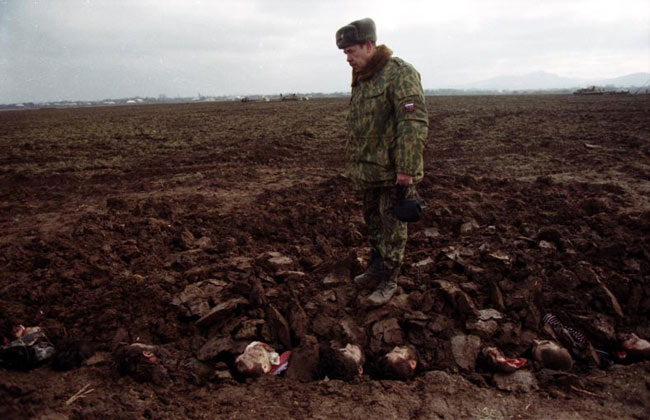On September 9, 1999, in southern Moscow, 94 people died when explosives laid at the foundation of their apartment building detonated, causing it to collapse. Four days later, another blast killed 118 in another apartment; three days after that, a truck bomb exploded near another building in Volgodonsk, killing 17. Vladimir Putin, just appointed Russian Prime Minister, cited a “Chechen trace” in the attacks. Despite Chechen President Aslan Maskhadov denying involvement, Putin ordered the re-invasion of Chechnya, marking the beginning of the Second Chechen War.
Russia’s failure to subdue Chechen nationalism during the First Chechen War (1994–1996) was still fresh in memory, and the 1999 attacks were framed as a justification for military intervention. However, Chechen involvement in the bombings remained uncertain. Multiple undetonated explosives were found near other apartment buildings which the Russian security service claimed to be using for training, and the government’s swift removal of rubble prevented a full investigation into the attacks. Despite this, the invasion and subsequent war were framed as a counter-terror operation. The war, which lasted until 2009, was marked by massive human casualties, with estimates ranging from 25,000 to 300,000, depending on the source. Human rights group Memorial estimates 50,000 civilian deaths.
This article examines the dynamics of identity during the Second Chechen War, using Brubaker’s social identity framework. It focuses on how the war shifted the political elite’s framing of Chechen identities from primarily nationalist orientations to religious affiliations, serving political and strategic goals. Brubaker’s theory explains how ethnicity, as a social category, becomes fluid in times of crisis, especially in conflict. While the Chechen War is often analyzed through the lens of territoriality and political sovereignty, identity also played a central role in how the conflict was framed, experienced, and sustained.
During the First Chechen War, Chechen identity was framed primarily in nationalistic terms, as Chechens fought for independence from Russia. However, as the war transitioned into a religiously charged conflict in the second phase, Chechen identity was framed as increasingly religious. This shift was, in part, a result of Chechen rebels seeking support from Islamist groups, such as al-Qaeda and the Taliban, whose influence grew in the region. This shift was not a rejection of nationalism but rather a reorientation of nationalist struggle through a religious lens.
This was also part of the process of “Chechenization” where Russian authorities, under President Vladimir Putin, sought to stabilize Chechnya by empowering local pro-Russia Chechen elites and leaders to control the region, rather than relying solely on Russian federal forces. The process of Chechenization involved delegitimizing all Chechen nationalist forces by labelling them as terrorists, thereby justifying their suppression by both Russian federal forces and the pro-Moscow Kadyrov regime, which has officially controlled Chechnya since 2007. This strategy facilitated the consolidation of power within Chechnya under leaders loyal to Moscow. By systematically portraying Chechen nationalist groups as terrorist entities, Russia framed its involvement in Chechnya within the broader context of the war on terror. This enabled the Kadyrov regime to employ counterterrorism laws and military tactics to dismantle these groups. The classification blurred the lines between legitimate nationalist aspirations and violent extremism, facilitating the elimination of opposition under the guise of counterterrorism.
The Chechenization strategy yielded domestic benefits for Russia as well. By emphasizing Islam as the core of the Chechen “enemy,” Russian elites could rally Russian nationalistic sentiment at home, focusing on the external threat to Russia’s stability and power. The use of the term “terrorism” as an overarching label for Chechen nationalism served to dehumanize the Chechen population and delegitimize their political goals. This framing supported the Russian government’s long-standing effort to suppress Chechen autonomy, presenting the conflict and possibility of Chechen independence as an existential threat rather than a political one.
Chechen identification itself was far more complex and fragmented. It was not simply nationalism or religion, but included a range of political and social affiliations. While some Chechens embraced Islamic identity as a rallying point, others resisted this shift, maintaining their commitment to secular Chechen nationalism and independence. These internal divisions further complicated the Chechen cause, and the external forces of Russian military power combined with the appeal of Islamic solidarity reshaped the social fabric of Chechnya.
This identity fluidity shows how social categories are not fixed but fluid in the context of war and occupation. For Chechens, the struggle for independence was reframed as a religious duty, while for Russians, understanding of Chechen identity shifted from national vis-a-vis Russia to one of radical Islamism. Both sides saw the war as existential, reinforcing the idea that identity, in times of conflict, is constantly reconstructed to justify political ends.
Brubaker’s social identity theory provides a valuable lens for understanding the transformation of Chechen identity during the Second Chechen War. By examining the shift from nationalism to religious affiliation, this approach reveals how identity categories are shaped by external forces and internal politics. In the context of the Second Chechen War, identity was not fixed but fluid, allowing both Chechens and Russians to use ethnicity, religion, and nationalism as tools of political mobilization. The conflict serves as a reminder of how identities can evolve in times of crisis and how these shifts are often manipulated to serve broader political goals.
Edited by Clio Bailey

I’m a writer for Catalyst and the McGill Journal of Political Science. I am passionate about topics such as politics, sustainability and geography!

